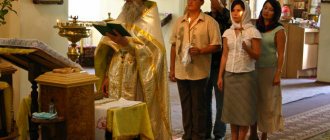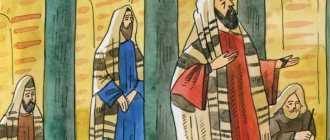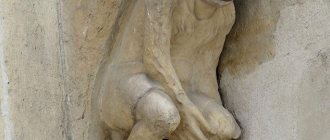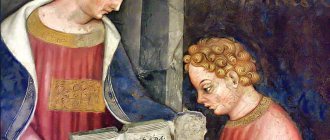Characteristics of the Sadducees
Considering the question of who the Pharisees and Sadducees are in the Bible, we first give characteristics to each of these religious movements. And later we will compare them with each other. Let's start with the Sadducees. Who is this? They can be briefly described as follows.
At the time of Jesus Christ, the Sadducees were an aristocratic branch of the Levite tribe. They had a desire for wealth and influential positions in society. Their representatives often held the positions of high priests, and also sat in the Sanhedrin - the supreme council, having a majority of seats there.
Until the middle of the 2nd century BC, all the highest positions of priests were filled by representatives of the descendants of Zadok, who, as stated in the book of Kings, was the high priest under King Solomon. There is an opinion that the meaning of the word “Sadducees,” which denotes the priestly aristocracy of New Testament times, is precisely connected with the name of this dynasty descended from Zadok.
History: appearance, Roman period
The Pharisees appeared at a time when the rule of the Maccabees reached its peak: around 150 BC. e. The Pharisees were the most numerous and influential Jewish party. Not only priests, but also politicians took their opinion into account.
The Pharisees so actively opposed the Maccabees, who combined political and spiritual power, that a popular uprising began in Israel during the time of Alexander Janna . As a result, 50,000 Pharisees' supporters died. Over time, the rulers made concessions and power was shared.
The most favorable time for the Pharisees was the reign of Alexander Yannai's widow, Solomea-Alexandra, after whose death her sons began to fight for power. Gnaeus Pompey, for help . He did not fail to take advantage of the favorable opportunity and made Judea a Roman province.
Caesar (left) and Pompey (right). Fresco by Taddeo di Bartolo (early 15th century).
In turn, the Pharisees turned to Pompey with a request to rid Israel of rival claimants to the throne and create a republic in the country under Roman leadership. Life under the guidance of the Mosaic Law, in peace and harmony with each other, was placed by the Pharisees above political independence.
During the time of Herod the Great (37-4 BC), the Pharisees lost their former political influence. Therefore, they decided to devote their energies to a deep study of the Law of Moses.
The teachings of the Pharisees and their righteousness
Although in the modern world the Pharisees are considered unambiguous villains or at least religious hooligans, history suggests that their teaching was heterogeneous. It contained views and teachings close to Christian ones.
By the time Jesus Christ came to our world, the teaching of the Pharisees reached its highest development in the person of the teacher Hillel (75 BC - 5 AD), who led the Jewish religious school.
One day a pagan approached him with a request to tell him about the essence of the Jewish Law. Hillel replied:
“Whatever you hate, do not do to your neighbor. This is the whole Torah. The rest is comments."
Shortly before the destruction of Jerusalem in 70, the Pharisees were divided into two camps. Hillel's followers called for peace with Rome, no matter the cost. The disciples of Shamai, on the contrary, stood at the head of the uprising and brought Israel to complete collapse.
Temple of King Solomon in Jerusalem, reproduction.
The teaching of the Pharisees was influenced by several factors:
- The religious monopoly of the Sadducees. The Pharisees taught people to pray and serve God not only in the temple, but also in the synagogue and at home.
- The desire to raise the spiritual and moral level of the people, as did the prophets of the Old Testament.
- Awareness of the limitations and imperfections of the provisions of the Mosaic Law.
The Pharisees tried to soften the literal understanding of the requirements of the Mosaic Law. Formally, they spoke of respect for it as God's revelation, but at the same time they tried in every possible way to protect it from any - even the smallest - violation, creating additional laws and rules that were prohibited by God himself. To do this, they created an oral Law, supposedly given by God himself to the Jews back in the Sinai desert.
Monastery Garden (Sinai).
The Pharisees preached moderate fatalism, believing that the Lord determines reality as a whole, but man is responsible for choosing his own path in life. They believed in the resurrection of the dead, the immortality of the soul and the coming of the Messiah, who would establish the Kingdom of God on earth.
Sadducees and people
At that time, the territory of Israel was completely controlled by the Romans, and the Sadducees tried to live in peace with them, supporting their decisions. Those around them had the impression that they were more involved in politics than in religious affairs.
Since they were a rich class and had no conflicts with Rome, their lives had little connection with ordinary people, they were outside the circle of interests of the Sadducees. Therefore, they did not feel favor from the people, to put it mildly. This was one of the differences between the Sadducees and the Pharisees. The latter were much more popular among the masses.
Many of the historians show the priestly aristocracy of Jerusalem as corrupt and having lost all respect among the people. But we cannot help but mention other opinions, according to which such a picture is only partially correct. In fact, for many Jews the figure of the high priest has not lost its significance. In the absence of a king from the line of David, it was believed that God sent a high priest to take charge of the people.
Publicans
Publicans are mercenaries of the Romans who came to the land of Israel and captured it. The Romans recruited publicans from local residents to collect taxes for the imperial treasury. There was a reason for this policy of the Roman authorities: Jewish society was closed to outsiders, so it was more convenient for those who knew all their tricks and secrets to extract all taxes from the rebellious Jews to the last coin. Simply put, publicans were traitors to their people.
The elder publicans were wealthy Jews who had enough money to buy the right to collect taxes from the Romans. Next, they hired subordinates, who were assigned an amount that they had to collect from the people in the area entrusted to them.
In addition to Roman taxes, tax collectors also had to extort money from people for their own profit. And for this they did not skimp on funds. Taking the last pennies from an unfortunate poor man and leaving a widow and children without a livelihood was a common daily practice for them.
The Jews were afraid to resist the publicans, because they were in the service of the Romans. They were simply hated and considered the worst enemies of God's people. Among the Jews they were outcasts despised by all. People were disdainful of sitting at table with them, avoided entering their houses and generally maintaining any communication. Therefore, for many it was a real shock to see the Teacher, respected by the people, visiting the elder tax collectors or at the same table with ordinary tax collectors. And for the tax collectors themselves, communication with Him was the only opportunity to talk with a respectable person about faith and salvation.
None of the rabbis - the Jewish teachers of piety - would ever agree to even approach these people, who made themselves outcasts among their own people. But for Jesus there were no outcasts. If the publicans wanted to repent of their atrocities before God and people, He always gave them such an opportunity, without any fear of ruining His reputation. Even among such hard-hearted people, He gathered His harvest for the Kingdom of Heaven. The Gospel tells about the chief of publicans, the rich man Zacchaeus , who, after communicating with Jesus, repented and decided to return with an increase everything that he had ever taken from people. According to legend, Zacchaeus subsequently became the first bishop of the Christian Church in Caesarea Palestine, a large city on the shores of the Mediterranean Sea. We know another repentant publican today as the apostle and evangelist Matthew.
The severity of the Sadducees
In religious terms, the Sadducees are a sect that did not recognize the oral tradition of the holy fathers, that is, those rules that were not set forth in written sources and, first of all, in the Torah. For the Pharisees, on the contrary, it was of very great importance. We will discuss this issue in more detail below.
As the 1st century Jewish historian Josephus wrote, the Sadducees' judgment was very harsh. He said that they were particularly cruel in passing sentences. Evidence is the story of how the high priest Anan, who belonged to the Sadducees, doomed James (the brother of Jesus Christ) to martyrdom. Around the year 62, the Jews threw Jacob from the wing of the temple in Jerusalem and stoned him.
Another evidence is contained in the New Testament, which tells that it was the Sadducees who crucified Jesus Christ. Researchers come to this conclusion based on the fact that the decision to execute him was made by the Sanhedrin, while it was led by the Sadducees.
Week of the Publican and the Pharisee: what is the essence
This week is part of the period preparing Orthodox Christians for Lent. At this time, the Church remembers the parable of the Pharisee and the publican. This is very important these days, because the world welcomes self-promotion, self-praise, arrogance and shamelessness. Self-criticism and humility have long become shortcomings. It is sad that this happens not only at the country level, but also in many religious groups.
And if believers welcome humility on a personal level, then at the confessional level it is considered a serious flaw. Yes, they don’t say this directly. But isn’t it hypocrisy to proclaim ourselves the only true Christians and preach about eternal hellish torment for everyone who differs from us in religious views? Observing fasting and other rituals when there is no humility does not bring us closer to God.
Pharisees means “distant”
The Pharisees and Sadducees differed, in particular, in that the former were not aristocrats, but the middle entrepreneurial class. Therefore, their communication with ordinary people was closer, and the people treated them more loyally. Despite the fact that they had a minority in the Sanhedrin, according to historians, their influence on decision-making can be defined as very significant.
The Pharisees had no connection with the Temple, that is, with the official Jerusalem hierarchy. According to researchers, they were mostly poor landowners or traders. But some of them completely devoted their lives to studying the Law and its interpretation.
The name of the religious sect "Pharisees" originates in the Hebrew "perushim" or Aramaic "perishaya". In both cases the meaning of the word is “separated.” This implies separation from sinners and people who are not distinguished by piety.
Essenes
In modern religion, the Essenes are perceived as an ancient sect of supporters of Christianity. They kept all of God's Commandments exactly. But they had their own way of life and did not accept strangers.
The historical fact of the existence of the Essenes has been confirmed by archaeologists. During excavations in 1947, near the Dead Sea, the remains of settlements, manuscripts, utensils and other household items were found. Numerous manuscripts found in those places were made public and were called the “Dead Sea Scrolls.”
The Essenes revered God, but did not believe in the resurrection of Christ. They strived in every possible way for a righteous life, and the sinfulness of big cities oppressed them.
Gradually the Essenes gathered into a large community. They did not recognize marriages, but accepted and raised “other people’s” children. They had all their property in common. They dined on one dish and bread. Everyone at the table was silent. They differed from all other Christian communities in the absence of division into masters and slaves. The Essenes had complete equality.
It was difficult to join the community; everyone had to prove loyalty to the faith and the ability to observe traditions. The probationary period lasted 3 years. They expelled those who stumbled and violated the laws of the community. Not adapted to independent life, observing the ban on accepting food from the hands of others, most of them died. There were cases when the repentant was forgiven and accepted back.
Keep the Sabbath day
In principle, the Pharisees did not completely exclude themselves from the lives of all other Jews and did not break off relations with the Jerusalem Temple. However, they believed that the people did not observe religious precepts scrupulously enough, doing so carelessly and very approximately.
A distinctive feature of the Pharisees was the desire for a detailed clarification of the instructions of the Old Testament, which were stated rather vaguely, and for their strict observance. At the same time, they assigned a huge role to the “traditions of the elders.” As a result, the norms that were established in Judaism at the beginning of our era were much more strict and detailed than those prescribed by the Pentateuch.
So, for example, the Mosaic Law gives a direct prohibition on working on the Sabbath day, requiring it to be given to the Lord God. At the same time, the word “work” is understood very broadly. For example, lighting a fire, writing more than one letter, or moving more than a certain number of steps is prohibited. All aspects of human life are regulated in the same detailed way - relationships between spouses, the process and time of cooking.
Thus, in relation to religion, the Pharisees believed that the written word was inspired by God, but at the same time they gave equal rights to oral traditions, insisting on their origin from Moses. Over time, they added traditions to the Word of God and strictly followed the rules from both of these sources.
Opinion of Josephus and the Apostle Paul
Josephus wrote in “Jewish Antiquities” that the distinctive feature of the Sadducee sect and their teaching from the teaching of the Pharisees is that the Pharisees transmitted to the people many laws based on ancient traditions that were not part of the legislation of Moses. The Sadducees completely reject these layers and demand compliance only with written laws, depriving oral tradition of any meaning. In this regard, many disagreements and disputes arose between the Pharisees and Sadducees.
In the “Acts” of the Apostle Paul, the teaching of the Pharisees is characterized as “the strictest in our religion.” Being adherents of ritual purity, they did not want to sit at the table not only with foreigners and people of other faiths, but also with other Jews if they believed that the latter were defiled by sin or did not carefully fulfill everyday religious instructions. The Pharisees carefully observed fasting, prayed for a long time, observed the Sabbath day, and strictly followed the regulations regarding the tithe due to the Temple.
The Apostles about the Pharisees
Acts 15 tells us that some Pharisees who became Christians were causing problems within the Church. They taught that Gentiles joining the Assembly needed to be circumcised and keep the Law of Moses. After this, a council of elders was convened in Jerusalem under the leadership of the apostles, where, under the influence of the Holy Spirit, it was decided:
Do not make it difficult for the pagans who turn to God, but write to them so that they abstain from what is defiled by idols, from fornication, strangulation and blood, and so that they do not do to others what they do not want for themselves.
(Acts 15:19,20)
But even after this, for many years the Apostle Paul struggled with the followers of the Pharisees who disagreed with the decision described above.
Sadducee Beliefs Contrary to Scripture
As mentioned above, in religious terms, the Sadducees are representatives of a more conservative branch of the doctrinally united direction of Judaism. They respected the authority of the written Word of God, denying oral sources. But at the same time, there are obvious contradictions in their beliefs with the Holy Scriptures, namely that the Sadducees:
- They were very self-sufficient, to the point of denying the presence and participation of God in everyday existence.
- They denied the doctrine of resurrection after death.
- They did not believe in life beyond the grave, but believed that souls die along with the body. It followed from this that there could be no punishment or reward after life on earth.
- They did not agree with the existence of a spiritual world with angels and demons.
However, what interested the Sadducees more than religion was politics. Therefore, Jesus Christ was at first indifferent to them. But then, as the Bible says, the Sadducees became afraid, deciding that there was a danger of attracting the attention of the Romans to him. And at that moment they united with the Pharisees, conspiring with them to bring about the death of Jesus. This issue will be discussed in more detail below.
Since the Sadducees were a party that existed through priestly and political connections, it disappeared after the Romans destroyed the Temple of Jerusalem.
The Sadducees (Σαδδουκαῖοι) are one of the three main schools (Latin secta, Greek αἵρεσις)[1] of Second Temple Judaism in the late Hellenistic (Hasmonean) and early Roman periods. We know much less about the Sadducees than about the Pharisees. The Sadducean texts, if they existed, have not survived to this day, and everything that we know about them has come to us from other sources, which were most often polemical in relation to this group[2]. From the Gospels, Acts, and the writings of Josephus, we learn that the Sadducees did not believe in the resurrection, the immortality of the soul, or oral tradition. The information that they did not believe in the existence of angels is found only in the book of Acts. Finally, Josephus alone contains information that they rejected the existence of fate and God's care for the world. Many believe that the Sadducees came from wealthy priestly families.
In modern biblical studies, the following topics generate heated debate: the origin of the Sadducees, the etymology of the name of the group, their teaching and social status. This article will briefly discuss all these difficult issues.
origin of name
Since texts written by the Sadducees themselves have not reached us, the researcher faces many problems, including the difficulty in determining the origin and etymology of the name of this Jewish sect. The first problem is that it is impossible to say for sure whether the name “Sadducees” is a self-designation [3] or whether they were called that only by their opponents. If they were called that only by their opponents, then they could call themselves differently or not have a self-name at all. There is another option: their opponents called them that, but over time they took this nickname as a self-name.
The second problem is the lack of consensus on the explanation of the name "Sadducee", which is not without philological difficulties[4]. There are several options for understanding this name:
1) The most common view in biblical scholarship is that the term Sadducee comes from the name Zadokite. The high priest Zadok served during the reigns of David and Solomon, and after the return of Israel from Babylonian captivity, only his descendants could be high priests (2 Kings 15:24, 27, 29, 35; 17:15; 19:11; 1 Kings 1: 39; 1 Chron. 6; 9:10-13; Ezek. 44:15). The pronunciation of the name Zadok as Sadduc (Σαδδουκ) is recorded in the Septuagint[5], Josephus[6] and in the vocalized manuscript of the Mishnah[7]. This option suggests a close connection between the Sadducees and the priests[8].
2) Some Church Fathers (for example, Epiphanius of Cyprus[9] and Jerome of Stridon[10]) believed that the name comes from the Hebrew adjective “just” or “righteous” (צַדִיק). It can be assumed that this name of the group implies a positive image of the Sadducean movement.
3) The name comes from the Hebrew adjective “righteous”, but has an ironic connotation denoting hypocrisy. Both Dead Sea cultists and rabbis often referred to people and groups in their texts not by their name, but by their nickname.[11]
4) According to the Talmudic tradition (Avot R. Nat. 5), the name “Sadducee” came from Zadok, a student of Antigonus of Socho, who, not understanding the maxims of his teacher, denied the afterlife and resurrection and created a sect in accordance with these views[12 ]. In modern science, few people share this point of view[13]. Jacob Newsner believes that this story may have been the author's invention.[14] Emil Schürer gives reasons why this origin is unconvincing: a) “Avot R. Nat. 5 is of later origin"; b) “the information about the Boetusei is incorrect”; c) “the legend is based not on tradition, but on scientific deduction, that is, that the Sadducees, who denied the immortality of the soul, came to their heresy through a misunderstanding of the statement of Antigonus of Socho: “This man should do good without worrying about future reward”” [15 ].
In rabbinic literature, the Sadducees are sometimes called Boethuseans. Some scholars suggest that the Boethuseans were a branch of the Sadducees, taking their name from their leader Boethus[16]. Simon ben Boethus was appointed high priest by his father-in-law Herod the Great in 24 BC, who was married to his daughter Mariamne[17].
Origin of the group
It is difficult to determine when the Sadducee sect was formed. It is even more difficult to name the reasons for its appearance. Menachem Mansur believes that they appeared ca. 200 BC[18]. Michael Satlow believes that the Sadducees appeared after 135 BC during the reign of John Hyrcanus, when the old pre-Hasmonean aristocracy (Pharisees) fought for influence at the royal court with the new aristocracy (Sadducees), who supported the Maccabean revolt[19]. Martin Goodman also dates the appearance of the Sadducees to the reign of John Hyrcanus, since Josephus first mentions them during his reign, but suggests that they could have appeared earlier [20]. In contrast, Günther Stemberger doubts that the Sadducees existed before the reign of Herod the Great, since there is only one mention of the group's existence before Herod. This is most likely the invention of Josephus, who attempted to carry "the political realities of his day back into the Hasmonean period to explain the disgrace of the Pharisees under Hyrcanus"[21] rather than under Herod. However, not all biblical scholars support a later date.
Social status
There is very little information about their social status in the surviving accounts of the Sadducees. Among specialists, a huge amount of scientific debate raises the question of whether the Sadducees came from wealthy families and whether they belonged to the priestly class.
Did the Sadducees belong exclusively to wealthy aristocratic families? Since ancient times, it has been customary in the scientific community to answer this question positively. Emil Schürer writes that the Sadducees were aristocrats, and they spread their teaching only among rich people[22]. The same point of view is shared by Ed Sanders, who argues that “not all aristocrats were Sadducees, but it is quite possible that all Sadducees were aristocrats.”[23] Josephus names only two Sadducees by name: the high priest Anan ben Anan (Ant. 20.9.1; cf. Acts 5:17) and the Hasmonean priest-king John Hyrcanus. According to Lester Grabbe, this indicates that “the Sadducees largely belonged to the upper socio-economic classes.”[24]
In biblical studies, there is also a negative answer to this difficult question. Andrew Das points out that Josephus uses the phrase πρώτους τοῖς ἀξιώμασι (Ant. 18.1.4) to denote prestige or reputation, and thus these words may refer to the reputation of the Sadducees' teaching rather than their social status.[25] In Ancient 13.10.6 notes that during the Hasmonean period the Sadducees were supported by wealthy people (εὔποροι), but Josephus does not tell us whether the Sadducees themselves were wealthy. He never claimed that the Sadducees were limited to a particular social group.
Were the Sadducees only priests? According to Menachem Mansur, the Sadducees came exclusively from among the priests who controlled the Temple[26]. There is another point of view. Michael Satlow argues that “not all rich priests were Sadducees, and not all Sadducees were priests.”[27] Emil Schürer writes: “They mainly belonged to the priesthood or were associated with it... This does not mean, however, that the Sadducees were exclusively a party of priests. The contrast between the Sadducees and the Pharisees was not a party of priests against a party of laity, but a contrast between the clerical and secular aristocracy in relation to a group of laity who derived their authority from learning. The Pharisees were by no means hostile to priests as such.”[28] Andrew Das believes that the main evidence about the Sadducees does not support the popular view that the sect had priestly origins. In his opinion, the origin of the name “Sadducees” from the name of the high priest Zadok does not yet indicate that they themselves are priests[29]. We do not find any connection between the Sadducees and the priesthood either in Josephus or the rabbis. Although Josephus Flavius in Ancient. 20.9.1 and speaks of the high priest Anan ben Anan as a Sadducee, but this passage does not suggest that the other high priests were Sadducees.[30] In Acts. 4:1 The Sadducees, along with the priests and the ruler of the Temple, arrest Peter and John. In this verse, the Sadducees are a separate group. Likewise, Acts. 4:5-6 gives no indication that any of the priests were Sadducees. Perhaps the reason for this division between priests and Sadducees is the poor familiarity of the author of Acts with this group.[31]
The question of the social status of the Sadducees is unlikely to be finally resolved in the near future[32], but at the current stage of the discussion the most optimal conclusion is to classify some Sadducees as a wealthy aristocratic class that had a close connection with the priesthood, while some of them were priests themselves[33] . It is impossible to say how many there were in the group, as well as whether it consisted of ordinary Jews from the cities and villages of Judea.
Teaching
It is difficult to reconstruct the Sadducean teaching on the basis of surviving evidence, but the following main provisions can be identified: denial of the existence of the soul and bodily resurrection; priority of the Pentateuch and denial of oral tradition; denial of fate; denial of the existence of angels and spirits. Menachem Mansur writes that the Sadducees were a conservative group who "clung to the old doctrines and had the greatest respect for the sacrificial cult of the Temple."[34] Most likely, the Sadducean canon did not contain all the books that we find in the modern Old Testament,[35] but the Pentateuch played an important role for them. Perhaps it was the recognition of the Law of Moses as the only authoritative religious text that influenced their worldview.
Afterlife and soul
The Sadducees did not believe that the soul continued to exist after death, that people were punished or received rewards after death (War. 2.8.14, Ancient. 18.1.4). This religious doctrine, which Josephus attributes to the Sadducees, raises serious questions if we believe that the Sadducees strictly observed the Pentateuch. Outi Lehtipuu puts it this way: “The descriptions of the Sadducees, both in the Acts and in the writings of Josephus, remain so vague that it is impossible to judge from them whether they actually denied the possibility of any form of afterlife or adhered to the traditional view that the dead continued to exist in the kingdom of shadows - Sheol"[36]. She also believes that the Pentateuch was of great importance to the Sadducees, and therefore they believed in an afterlife (Sheol), but denied further development of the idea of an afterlife in intertestamental literature. If we assume that the Sadducees had their own tradition of interpretation of the Pentateuch (see below), then they may well have abandoned the idea of an afterlife and emphasized this life. Apparently, this approach was an attempt to maintain their status as an aristocratic priesthood.[37] The basis for this interpretation would most likely be the “blessings and curses” of Deuteronomy. In Deut. 28:1 says that one must “carefully do all the commandments” of God in order to be blessed and live well in the land of Israel. The doctrine of the afterlife (Sheol) is not among the commandments of the Law, and Sheol itself is rarely mentioned in the Pentateuch.
Resurrection
The New Testament specifically emphasizes that the Sadducees denied the resurrection (Matt. 22:23-33; Mark 12:18-27; Luke 20:27-40; Acts 23:6-8), since the question of the resurrection was of central importance to the early Church. In Avot R. Nat. 5 reports that Zadok's followers "separated from the path of the Torah" over the issue of the resurrection. All of these sources indicate that the Sadducees were known for their rejection of the idea of the resurrection.[38] The Church Fathers usually associate this with the Sadducees' rejection of the prophetic books of the Old Testament. The reason why the Sadducees did not accept the resurrection, according to Günter Stemberger, is that the idea appeared during the Maccabean period. This new teaching was accepted by many other than the conservative Sadducees[39]. Lester Grabbe believes that the Sadducees rejected the doctrine of the resurrection because it was a difficult idea to understand: “They may have rejected some traditional interpretations that included complex <…> reasoning about the eschaton.”[40] It is possible that the Sadducees did not recognize the resurrection for the same reason that they did not recognize the afterlife (see above).
Pentateuch and oral tradition
Some researchers believe that the Sadducees strictly adhered to the Law of Moses[41]. Unlike the Sadducees, the Pharisees gave oral tradition authority on par with the Pentateuch. In turn, the Sadducees refused to recognize any oral command of the Pharisees as binding. Other scholars believe that, in fact, the rejection of the oral tradition of the Pharisees does not mean that the Sadducees did not have their own tradition of interpreting the Pentateuch. Martin Goodman writes: “It is very difficult to understand how one can rely solely on the biblical text. Like later fundamentalists such as the Karaites, the Sadducees must have developed their own system of interpretation, regardless of what they claimed to do with the tradition."[42] In the Talmud, the main point of contention between the Sadducees and the Pharisees/Rabbis is the topic of purity laws. This is not surprising given the importance of the idea of purity in Second Temple Judaism. What is important for us is this additional evidence from the Talmud, which points to the existence of a tradition of interpretation among the Sadducees.
Perhaps we can agree with Gary Porton, who very sensitively defines the way each religious movement of Second Temple Judaism relates to its rival's interpretation of the Pentateuch: “Each group used to claim that it alone was faithful to the Law and that only it taught what was contained in the Law. To claim that the Sadducees rejected the oral law of the Pharisees is simply to claim that the Pharisees were not Sadducees."[43]
Fate
Josephus reports in Wars. 2.8.14 that the Sadducees denied fate and argued “that God has no influence over human actions, either evil or good”[44]. They also believed that “the choice between good and evil is left to the completely free will of man, and everyone, at his own discretion, goes over to one side or the other”[45]. This view is difficult to reconcile with the biblical tradition of God's intervention in human history (providence). This idea was typical of the Epicureans. It should be understood that Josephus wrote about the Jewish groups of his time in Hellenistic terms and not for Jews, so they did not necessarily accurately reflect the views of the Sadducees themselves, but were close to understanding for an educated aristocrat in the Roman Empire.
The doctrine of free will may well have been consistent with the worldview of the Sadducees and their status as rich and powerful men, who may have believed that money, influence, and power came not through fate or chance, but through personal qualities and deliberate choices.[46] Of course, this option is quite possible, but it is more likely that Josephus attributed this teaching to them in order to integrate them into his system of comparing the three main Jewish schools of thought with the main Greek philosophical schools. “He compares the Pharisees with the Stoics, and the Essenes with the Pythagoreans (Life 2.12; Ancient 15.10.4). Comparing these two groups with these schools implies that he is comparing the Sadducees with a third Greek school, the Epicureans. Josephus does not say this directly, but this is how many scientists understood his words.”[47]
Angels and spirits
The fact that the Sadducees denied the existence of angels is stated only in Acts. 23:8: “For the Sadducees say that there is neither resurrection, nor angel, nor spirit.” Andrew Das believes that this is “an example of gendiadis referring to one group - the angels”, since “the next phrase says that the Pharisees, for their part, recognized “both”: the resurrection and angels/spirits”[48]. If we consider the Sadducees to be a conservative group who strictly adhered to the Law of Moses, then we have a problem because the Pentateuch mentions angels. Lester Grabbe suggests that "they may have rejected some traditional interpretations that included complex angelology (such as we find in 1 Enoch.)"[49]. Or perhaps their denial of angels is closely related to their denial of the resurrection. In this case, the Sadducees could object to the idea that after the resurrection all the righteous "will be like angels" (2 Bar. 51:10) or that "the spirits of those who died in righteousness will live and rejoice, and their spirits will not perish" ( 1 Enoch 103:4)[50]. If the Sadducees had their own tradition of interpreting the Pentateuch, then they could reject angelology as an optional teaching.
Sadducees after the destruction of the Temple
There are two points of view on the interpretation of the event that happened to the Sadducees after the destruction of the Jerusalem Temple by the Romans. Some suggest that the Sadducees disappeared immediately after the destruction[51]. This view is based on the assumption that all Sadducees were priests. After 70 AD The decline of the rural aristocracy (whose representatives were mainly from priestly families) began, caused by the devastation of the country, the confiscation of a large part of the land and the end of the autonomous Jewish administration, which led to the disappearance of the Sadducees[52].
Other researchers believe that the Sadducees continued to exist long after the destruction of the Temple, but their popularity became even less popular than before the destruction, which led to the disappearance of the group. Josephus, in his autobiography Life, written around 93 AD, mentions the Sadducees as a still existing sect. Andrew Das writes: “The silence of later sources does not prove that the Sadducees disappeared. Even rabbinic sources, which say relatively little about the Sadducees, or other Jewish groups for that matter, do not claim that they ceased to exist (m. Nid. 4:2 [daughters of the Sadducees]; t. Nid. 5:2 -3 [Sadducee women]; b. Nid. 33b [Sadducee women]; b. Šabb. 108a [Boethuseans]). The loss of the Temple was no obstacle to the group, which emphasized its own commitment to the written biblical Revelation."[53] So does Martin Goodman: “There is no good reason to believe that their approach to the Bible could not have continued long after the Second Temple period, since nothing in the views attributed to them required the continuation of the Temple.”[54]
Conclusion
So who are the Sadducees? Who were they? What did they believe? Most likely, the Sadducees appeared in the Hasmonean period, perhaps a little earlier, but began to disappear from the historical scene after 70 AD. They are often identified with priests and wealthy aristocratic families, but it is quite possible that the Sadducees could have included poor residents of Jerusalem and Judea. They were a conservative group, strictly guided by the Pentateuch as their authoritative text, but this does not mean that they did not have their own tradition of interpretation of the Law of Moses. For this reason, they rejected what was not in the Pentateuch: retribution after death, resurrection, developed angelology - everything that was popular not only among the Pharisees, but also among the ordinary Jewish people.
Martin Goodman describes the movement as follows: “It is probably correct to think of the Sadducees as a marginal group in the broader history of late Second Temple Judaism. That their philosophy was incompatible with Pharisaism is clear in light of the extensive evidence of disputes between these groups, but their views on the absence of life after death and their teaching that God has no influence on the world also make it difficult to unite their philosophy with most others branches of Judaism"[55]. But, according to Ed Sanders, “on the whole they were good Jews,” as they tried to strictly observe the injunctions of the Pentateuch.[56]
We see that due to the lack of Sadducean texts and the extremely scant and negative information about them, it is difficult to reconstruct their history and teaching. Therefore, it must be remembered that “any historical reconstruction must be considered extremely unreliable”[57].
Bibliography
Epiphanius of Cyprus, St. Creations. Volume 1. M: Printing house V. Gautier, 1863. - 384 p.
Jerome of Stridon, blessed. Creations. Volume 16. Kyiv: Korczak-Novitsky Printing House, 1903. - 390 p.
Josephus Flavius. Jewish War. Translation by Ya.L. Chertka, 1900 // Vekhi Library. [Electronic resource.] URL: https://www.vehi.net/istoriya/israil/flavii/voina/02.html (access date: 02/08/2020).
Boethusians // Encyclopedia Judaica (2nd ed.), Volume 4 (Blu-Cof). Edited by Berenbaum M., Skolnik F. New York: Macmillan Reference USA, 2006. - P. 33-34.
Das AA Sadducees // The Lexham Bible Dictionary. Edited by Barry JD, Bomar D., Brown DR, Klippenstein R., Mangum D., Sinclair-Wolcott C., Widder W. Lexham Press/Logos, 2016. [Electronic resource.] URL: https://app.logos .com/books/LLS%3ALBD/headwords/Sadducees?layout=one.
Goodman M. A History of Judaism. Princeton: Princeton University Press, 2022. - 656 p.
Goodman M. The Place of the Sadducees in First-Century Judaism // Redefining First-Century Jewish and Christian Identities: Essays in Honor of Ed Parish Sanders. Edited by Udoh F.E., Heschel S., Chancey M., Tatum G. Notre Dame: University of Notre Dame Press, 2008. - P. 139-152.
Grabbe LL An Introduction to Second Temple Judaism: History and Religion of the Jews in the Time of Nehemiah, the Maccabees, Hillel, and Jesus. London: T&T Clark International, 2010. - 166 p.
Lehtipuu O. Debates over the Resurrection of the Dead: Constructing Early Christian Identity. Oxford: Oxford University Press, 2015. - 256 p.
Mansoor M. Sadducees. // Encyclopedia Judaica (2nd ed.), Volume 17 (Ra-Sam). Edited by Berenbaum M., Skolnik F. New York: Macmillan Reference USA, 2006. - p. 654-655.
Neusner J. The Rabbinic Traditions about the Pharisees before 70, Part I: The Masters. Leiden: EJ Brill, 1971. - 436 p.
Newman H. Proximity to Power and Jewish Sectarian Groups of the Ancient Period: A Review of Lifestyle, Values, and Halakha in the Pharisees, Sadducees, Essenes, and Qumran. Leiden: Brill, 2006. - 332 p.
Porton GG Sadducees. // The Anchor Bible Dictionary. Volume 5 (O-Sh). Edited by Freedman DN New York: Doubleday, 1992. - P. 892-895.
Saldarini AJ Pharisees, Scribes, and Sadducees in Palestinian Society: A Sociological Approach. Grand Rapids: Eerdmans, 2001. - 356 p.
Sanders EP Judaism: Practice and Belief, 63 BCE-66 CE. Philadelphia: Trinity Press International, 1992. - 580 p.
Satlow ML How the Bible Became Holy. New Haven: Yale University Press, 2014. - 368 p.
Schürer E. The History of the Jewish People in the Time of Jesus Christ (175 BC-AD 135), Volume II. Edinburgh: T. & T. Clark Ltd., 1979. - 624 p.
Stemberger G. The Sadducees – Their History and Doctrines // The Cambridge History of Judaism. Vol. 3: The Early Roman Period. Edited by Horbury W., Davies W.D., Sturdy J. Cambridge: Cambridge University Press, 1999. - P. 428-443.
[1] Here and below, the term “sect” does not have a negative connotation and is used in the neutral meaning of the religious movement (direction, school) of Second Temple Judaism.
[2] Goodman M. A History of Judaism. Princeton: Princeton University Press, 2022. P. 122: “Josephus <...> described the Sadducees in deeply unflattering terms <...> The Gospels and Acts, and the early rabbis express similar hostility. No Sadducean literature survives to contradict such a description or to really fill in the gaps in Sadducean teaching.” See also: Grabbe LL An Introduction to Second Temple Judaism: History and Religion of the Jews in the Time of Nehemiah, the Maccabees, Hillel, and Jesus. London: T&T Clark International, 2010. P. 57; Stemberger G. The Sadducees – Their History and Doctrines // The Cambridge History of Judaism. Vol. 3: The Early Roman Period. Edited by Horbury W., Davies W.D., Sturdy J. Cambridge: Cambridge University Press, 1999. P. 428.
[3] Satlow ML How the Bible Became Holy. New Haven: Yale University Press, 2014. P. 142.
[4] Das AA Sadducees // The Lexham Bible Dictionary. Edited by Barry JD, Bomar D., Brown DR, Klippenstein R., Mangum D., Sinclair-Wolcott C., Widder W. Lexham Press/Logos, 2016. [Electronic resource.] URL: https://app.logos .com/books/LLS%3ALBD/headwords/Sadducees?layout=one (accessed 02/08/2020).
[5] The name Zadok is mentioned 53 times in the Old Testament (LXX), of which 10 are in the form Σαδδουκ and are found in Ezekiel, Ezra and Nehemiah (Ezek. 40:46; 43:19; 44:15; 48:11; Ezra. 7:2; Neh. 2:4, 29; 10:21; 11:11; 13:13).
[6] Pharisee Sadduc (Σαδδουκος) is mentioned in Ancient. 18.1.1.
[7] In Cod. de Rossi 138 the name of Rabbi Zadok is indicated in only a small number of passages, more often it is read as Sadduk.
[8] Of course, this option is the highest priority in biblical studies, but it still raises a lot of questions. Thus, Gunther Stemberger writes: “The last Zadokite high priest was Jason (175-172/1 BC). Shortly thereafter, the Hasmoneans usurped the high priesthood (Jonathan in 152 BC). After this, part of the Zadokites retired to Egypt, where Onias IV founded a temple in Leontopolis, and another group of Zadokites led the Qumran movement. If the Sadducees, together with the Pharisees, really appeared at the beginning of the Hasmonean reign, it would be strange if they took their name from the Zadokites, who were then deprived of power, unless they are considered as an opposition party to those Zadokite priests who remained in Jerusalem. Or are we to assume that the new high priests claimed the dignity of the Zadokite race? Did the people really call the priests, regardless of their true origin, the sons of Zadok? Should this name be considered a nickname imposed on the temple priests by their opponents? Stemberger G. The Sadducees – Their History and Doctrines. P. 431.
[9] See: Epiphanius of Cyprus, St. Creations. Volume 1. M: Printing house V. Gautier, 1863. P. 69.
[10] See: Jerome of Stridon, blessed. Creations. Volume 16. Kyiv: Korczak-Novitsky Printing House, 1903. P. 229.
[11] For example, the "wicked priest" in the Dead Sea Scrolls, and in rabbinic literature Simon Bar Kosiba, the leader of the revolt of 132-135, is called Bar Kochba or Bar Koziba. See: Goodman M. The Place of the Sadducees in First-Century Judaism // Redefining First-Century Jewish and Christian Identities: Essays in Honor of Ed Parish Sanders. Edited by Udoh F.E., Heschel S., Chancey M., Tatum G. Notre Dame: University of Notre Dame Press, 2008. P. 141; Saldarini AJ Pharisees, Scribes, and Sadducees in Palestinian Society: A Sociological Approach. Grand Rapids: Eerdmans, 2001, pp. 225-226.
[12] Mansoor M. Sadducees // Encyclopedia Judaica (2nd ed.), Volume 17 (Ra-Sam). Edited by Berenbaum M., Skolnik F. New York: Macmillan Reference USA, 2006. P. 654.
[13] Porton GG Sadducees // The Anchor Bible Dictionary. Volume 5 (O-Sh). Edited by Freedman DN New York: Doubleday, 1992. P. 892.
[14] For more on this, see: Neusner J. The Rabbinic Traditions about the Pharisees before 70, Part I: The Masters. Leiden: E. J. Brill, 1971. P. 60-61.
[15] Schürer E. The History of the Jewish People in the Time of Jesus Christ (175 BC-AD 135), Volume II. Edinburgh: T. & T. Clark Ltd., 1979. P. 406-407.
[16] Mansoor M. Sadducees. P. 654; Stemberger G. The Sadducees – Their History and Doctrines. P. 434.
[17] Boethusians // Encyclopedia Judaica (2nd ed.), Volume 4 (Blu-Cof). Edited by Berenbaum M., Skolnik F. New York: Macmillan Reference USA, 2006. P. 33.
[18] Mansoor M. Sadducees. P. 654.
[19] Satlow ML How the Bible Became Holy. P. 125, 137.
[20] Goodman M. A History of Judaism. P. 123.
[21] Stemberger G. The Sadducees – Their History and Doctrines. P. 430-431. But still, Stemberger comes to the conclusion that “neither the theory of their origin in the Maccabean period, nor the theory of their origin in the reign of Herod can be proven with absolute certainty” (p. 433).
[22] Schürer E. The History of the Jewish People in the Time of Jesus Christ (175 BC-AD 135), Volume II. P. 404.
[23] Sanders EP Judaism: Practice and Belief, 63 BCE-66 CE. Philadelphia: Trinity Press International, 1992. P. 318.
[24] Grabbe LL An Introduction to Second Temple Judaism. P. 58. Although Grabbe makes a reservation that it is impossible to say with complete certainty that “all the Sadducees were either rich or connected with the priesthood.”
[25] Das AA Sadducees. [Electronic resource.] URL: https://app.logos.com/books/LLS%3ALBD/headwords/Sadducees?layout=one (access date: 02/08/2020).
[26] Mansoor M. Sadducees. P. 654.
[27] Satlow ML How the Bible Became Holy. P. 191. See also Stemberger G. The Sadducees – Their History and Doctrines. P. 433: “They are usually associated with the Temple and the priesthood. But we have no right to identify them simply with a group of temple priests.”
[28] Schürer E. The History of the Jewish People in the Time of Jesus Christ (175 BC-AD 135), Volume II. P. 404.
[29] Das AA Sadducees [Electronic resource.] URL: https://app.logos.com/books/LLS%3ALBD/headwords/Sadducees?layout=one (access date: 02/08/2020).
[30] It is worth agreeing with Martin Goodman's statement: “The fact that Josephus Flavius explicitly called Ananus a Sadducee suggests that being a Sadducee could not be taken for granted by the high priests” (Goodman M. A History of Judaism, p. 127).
[31] Sanders EP Judaism: Practice and Belief, 63 BCE-66 CE. P. 318: “The writers of the Gospels and Acts had little knowledge of the Jewish parties.” It is also worth noting that for the New Testament, “the Sadducees are completely secondary to the Pharisees, who are presented as the main group of Judaism and the only important opponents of Jesus” (Stemberger G. The Sadducees – Their History and Doctrines, p. 428).
[32] Martin Goodman makes an important point: “These gaps are not as easy to fill on the basis of ancient evidence as might be suggested by the self-confident statements of scholars, both Jewish and Christian, who have maintained since the 19th century that the Sadducees were secular, Hellenistic, wealthy aristocrats of priestly origin, who had connections with the high priests and the Roman administration and were conservative in their interpretation of the Torah. Almost all of these traditional ideas turn out, on closer examination, to be either incorrect or unprovable...” (Goodman M. A History of Judaism, p. 122).
[33] Grabbe LL An Introduction to Second Temple Judaism. P. 58.
[34] Mansoor M. Sadducees. P. 654.
[35] Grabbe LL An Introduction to Second Temple Judaism. P. 58.
[36] Lehtipuu O. Debates over the Resurrection of the Dead: Constructing Early Christian Identity. Oxford: Oxford University Press, 2015. P. 25, n. 10.
[37] Das AA Sadducees [Electronic resource.] URL: https://app.logos.com/books/LLS%3ALBD/headwords/Sadducees?layout=one (access date: 02/08/2020).
[38] Porton GG Sadducees. P. 893-894.
[39] Stemberger G. The Sadducees – Their History and Doctrines. P. 440-441.
[40] Grabbe LL An Introduction to Second Temple Judaism. P. 58.
[41] Schürer E. The History of the Jewish People in the Time of Jesus Christ (175 BC-AD 135), Volume II. P. 411: “...the Sadducees represented the more ancient point of view: they stood for the written Torah.”
[42] Goodman M. A History of Judaism. P. 125.
[43] Porton GG Sadducees. P. 894.
[44] Josephus. Jewish War. Translation by Ya.L. Chertka, 1900 // Vekhi Library. [Electronic resource.] URL: https://www.vehi.net/istoriya/israil/flavii/voina/02.html (access date: 02/08/2020).
[45] Ibid.
[46] Stemberger G. The Sadducees – Their History and Doctrines. P. 440.
[47] Newman H. Proximity to Power and Jewish Sectarian Groups of the Ancient Period: A Review of Lifestyle, Values, and Halakha in the Pharisees, Sadducees, Essenes, and Qumran. Leiden: Brill, 2006. P. 74.
[48] Das AA Sadducees [Electronic resource.] URL: https://app.logos.com/books/LLS%3ALBD/headwords/Sadducees?layout=one (access date: 02/08/2020).
[49] Grabbe LL An Introduction to Second Temple Judaism. P. 58.
[50] Stemberger G. The Sadducees – Their History and Doctrines. P. 441-442.
[51] This is what Menahem Mansur, for example, thinks (Mansoor M. Sadducees, p. 655).
[52] Stemberger G. The Sadducees – Their History and Doctrines. P. 435.
[53] Das AA Sadducees [Electronic resource.] URL: https://app.logos.com/books/LLS%3ALBD/headwords/Sadducees?layout=one (access date: 02/08/2020).
[54] Goodman M. A History of Judaism. P. 128.
[55] Goodman M. A History of Judaism. P. 127.
[56] Sanders EP Judaism: Practice and Belief, 63 BCE-66 CE. P. 332.
[57] Grabbe LL An Introduction to Second Temple Judaism. P. 57.
What did the Pharisees believe?
In contrast to the Sadducees, the Pharisees believed that:
- All things around are subject to the control of the Almighty, but at the same time, the decisions that are made by a person in a certain way influence the course of his life.
- When a person dies, his soul does not die, and he rises from the dead.
- There is an afterlife, which depends on what a particular person deserved during life - reward or punishment.
- Along with people in the world, there are both bright angels and dark ones - demons.
As mentioned above, after the destruction of Jerusalem, the Sadducees ceased to exist, while the Pharisees, more focused on religion, continued to exist. The Pharisees were against the rebellion that led to the destruction of Jerusalem in 70 AD. They were among the first to make peace with the Romans after this. The Pharisees are credited with compiling the Mishnah, a very important document that describes the continued existence of Judaism after the destruction of the Temple.
Pharisees
The word “Pharisees” is used so often in the Gospel that you inevitably begin to perceive it as something important that you definitely need to know about. It is the Pharisees who constantly argue with Jesus, ask him tricky questions, and try to catch Him in contradictions. In turn, Jesus denounces them in every possible way for hypocrisy, distortion of the Law of God, and excessive enthusiasm for external piety. Why did Jesus have such a strong confrontation with the Pharisees?
The answer here is simple: those who are most firmly committed to the old teaching challenge the new teaching more than others. The Pharisees considered themselves the most zealous fulfillers of God's commandments. The very word “Pharisee” means “isolated”, “separated” from all other Jews who do not live according to such strict rules. And indeed, the Pharisees tried very hard to live righteously. But at the same time they treated other people with disdain, considering them lower than themselves before God.
Ordinary people took them into account, revered them as teachers of the Law, feared their anger and never dared to argue with them about objects of faith. Therefore, the preaching of the unknown son of a carpenter was perceived by the Pharisees as unheard of insolence. If she had been less successful, she simply would not have been noticed. But the words of Jesus sounded with power, they changed the souls of people, calling them to a new life. Hundreds of followers followed the new Teacher, His speech attracted crowds of thousands of listeners who came from various cities and villages.
Of course, the Pharisees saw Him as a threat to their spiritual authority. Moreover, in reality this authority turned out to be largely dubious and unfounded. Thus, when distributing alms to the poor, the Pharisees used to gather a crowd of spectators around them so that they could observe their generosity. While observing fasting, they deliberately dressed in shabby clothes and painted their faces with white paint, so that those around them could see that they were exhausted from their Lenten exploits. During temple services, the Pharisees stood in the very first row of worshipers to emphasize their superiority.
Outwardly, they stood out from the crowd of ordinary residents of Israel with their clothes, which deserve special mention here. During the next rebuke of the Pharisees for their ostentatious piety, Jesus spoke about them to the people: ... yet they do all their works so that people can see them: they enlarge their storehouses and enlarge the waists of their garments... (Matthew 23:5). It is not at all clear from the text of the Gospel what kind of storage and storage of clothing we are talking about here. And these were precisely those very Pharisee insignia.
A Greek word is translated as “repository” in the Russian text of the Gospel, which has several meanings: protection, fortification, fortress, watchtower, as well as something that protects: an amulet, a talisman. In this case, the storage is what protects its owner. This was the name of the square leather boxes on which were written the words of the prophets who proclaimed the will of God to the people of Israel. The Pharisees tied them to their foreheads and to their left hands as a literal fulfillment of God's commandment: ...Therefore put these words of Mine in your heart and in your soul, and bind them as a sign on your hand, and let them be a blindfold over your eyes (Deut. 11 :18). These boxes were called tefillin. The Pharisees attached them to leather bands and wore them on their hands and foreheads. Apparently, in order to put more sacred texts on the tefillin, some of the Pharisees made these talisman boxes of absurdly large sizes, which is what Christ mentioned.
The Russian expression “voskriya odezh” can also mislead the inexperienced reader. The Greek word used by the evangelist in this case does not mean the tails of the cloak at all. Here we are talking about tzitzit - tassels that had to be sewn on the edges of clothes so that they would constantly remind them of the commandments of God and the need to lead a righteous life: ...And the Lord spoke to Moses, saying: Speak to the children of Israel and tell them to make tassels for themselves on the edges their garments throughout their generations, and in the tassels that were at the edges they inserted threads of blue wool; and they will be in your hands so that, looking at them, you will remember all the commandments of the Lord and fulfill them, and not follow your heart and your eyes, which lead you to fornication, so that you will remember and fulfill all My commandments and were holy to your God (Numbers 15:37–40).
Being carried away by such details, the Pharisees almost lost the main meaning of the Scripture, which they undertook to interpret before ordinary people. Instead of love and mercy for their neighbors, they made the main goal of their piety the meticulous adherence to various ritual details. And they were very proud to observe these rituals. It was for this misunderstanding of the essence of God's Law that Jesus scolded them, trying to reach their hearts. The Pharisees tried to kill Him with stones in the temple courtyard. But nevertheless, it was from among them that Nicodemus , who was not afraid to stand up for Christ when the high priests sent their servants to arrest Him. Joseph was a Pharisee, who risked directly turning to the Roman governor of Judea, Pontius Pilate, with a request to give him the body of Jesus for burial. Gamaliel was a Pharisee - the most authoritative teacher of the Law, who defended the apostles John and Peter arrested by the Jews at the trial. Finally, the Pharisee was the one whom Jesus Himself would later call His chosen vessel - the Apostle Paul , the enlightener of the pagans, who founded many Christian churches outside of Israel among other nations.
Despite their errors, many Pharisees sincerely sought to please God; their souls were not dead to accept the Good News about God, who had come to atone for the sins of people with His death. For this reason, the Lord denounced them so persistently, trying to save at least some.
Who are scribes?
Along with the Pharisees and Sadducees in the New Testament, Jesus Christ often criticizes the scribes. As a rule, he begins his denunciations with the phrase: “Woe to you, Pharisees and scribes, hypocrites.” Who are these scribes?
Scribes were a profession practiced among Jews that involved writing Torah scrolls and other religious sources. They were also called sofers, or soifers. In Russian, these are scribes.
They wrote manuscripts using a special square script - the Assyrian script in which the Tablets of the Testament were written. This specialty required the development of special techniques, knowledge of the laws of lettering, and extraordinary concentration.
In addition, the scribe must be a God-fearing person, honest and strictly follow the commandments of the Torah. They formed a learned corporation and became the first of the interpreters of the Holy Scriptures. The sofers lived in the city of Ibais and were mainly from the tribe of Levi.
Some authors, such as Epiphanius of Cyprus and John of Damascus, identified the scribes as a separate Jewish heretical sect. However, today such a distinction is considered incorrect, since the scribes could well have been both Pharisees and Sadducees. Therefore, the words of Jesus Christ regarding the scribes must be considered in a figurative sense - as people formally related to the faith.
Pharisees, Jesus Christ, Sadducees
As stated in the Gospels, the Son of God had many claims against both religious sects. He did not agree with the fact that the Sadducees denied those provisions of the Holy Scriptures mentioned above, nor with the fact that the Pharisees gave equal rights to oral tradition, which is prohibited by the Bible.
He also opposed the excessive formalism inherent in the teachings of the Pharisees, since a person’s relationship with God should not be reduced only to the mindless performance of rituals and following a strict list of rules. As stated in the New Testament, Jesus was also unpopular with both the high priests and most of the Sadducees and Pharisees. He constantly exposed the hypocritical behavior of both.
One of the main opponents of Christ is the high priest Caiaphas. After all, when the Savior kicked the money changers out of the temple, he caused great material damage, including to Caiaphas personally. Moreover, the high priest was very much afraid that the increasing popularity of the preacher from Nazareth among the Jews might eventually lead to a Roman invasion. And this, in turn, leads to the loss of his high position.
Therefore, having gathered together, the Pharisees and Sadducees, represented by the high priests and other religious leaders, decided to hand him over into the hands of Rome in order to put him on trial and execute him.
The meaning of the Greek word used in the Gospel
The word “Pharisee” came to the Russian language from Greek, in which it was formed from the Aramaic “perushim” - “to separate (sya).” This means that the Pharisees are the ones who separate.
It remains unclear who exactly named these Jewish religious teachers. Perhaps these were opponents of the Pharisees.
Is hypocrite a synonym?
After the widespread spread of the Gospel, “Pharisee” became synonymous with “hypocrite.” The special holiness of the Pharisees was only a beautiful shell, behind which extraordinary arrogance, impurity, unbelief, lust for power and cruelty were hidden.
Other synonyms
The word "Pharisee" has several other synonyms:
- Jesuit;
- pretender;
- hypocrite;
- empty-headed;
- holy man
What does Pharisaism mean?
The Pharisees were righteous in their own eyes without measuring their own behavior and thinking against God's truths. But towards others they were often extremely unmerciful.
Jesus and the Jews
And how did the entire Jewish people, who are often reproached for being the collective culprit of the crucifixion of Jesus Christ, react to this? Trying to answer this question, let's turn to the primary sources. Thus, the Gospel of Matthew says that a crowd of Jews, appealing to Pontius Pilate, demanded that he crucify Jesus, while accusing the latter: “His blood lies on us and our children.”
Does it follow from this that we must conclude that all Jews living in Jerusalem in the 1st century should be considered as murderers of Christ? Let’s not rush into this and cite the words of another Gospel author, John, who testifies to the extraordinary popularity of Christ among this people. This is especially true of Galilee, to which he devoted a greater period of his ministry.
Again, the Gospel of Matthew indicates that just 5 days before Jesus was arrested and executed, he was greeted as the Messiah by a crowd of Jews entering Jerusalem. So who needed the death of Christ? Matthew notes that it was the “chief priests and elders” who instigated only a small group of Jews.
As for the people, they became a silent witness, essentially approving the crime of their leaders, the true culprits of the bloodshed. It was precisely for this tolerance shown by the Jews towards the bloody acts of high-ranking representatives of the Sadducees and Pharisees that responsibility for them was placed on the entire people.
Modern Pharisees
Some hotels in modern Israel are equipped with elevators that automatically stop on each floor, so that the visitor does not have to do the “hard” work by pressing a button.
But throughout the world these days, other types of pharisaism are most often found. Here are its characteristic features:
- Indifference to the truth. This is a very common problem among believers. Many people believe that there is no need to think for themselves, because we have the Fathers of the Church, modern theologians and pastors to whom we can shift responsibility for our beliefs.
- Reducing religion to formal observance of duties, but not to the transformation of personality and the manifestation of Christian qualities. Many are cunning, thinking that observing rituals gives the right to commit new sins.
- Delusions of grandeur, expressed in the desire to teach others in accordance with personal rules. It is terrible when pastors display such a trait. In the history of religion, there are cases when leaders established rules according to which believing spouses had to fulfill their marital duty, which led to serious family problems and even divorces.
- Double standards. For example, in church a person behaves decently, but at home he insults his neighbors, abuses alcohol, smokes and uses foul language.
- The complex of the eternal prosecutor and judge. Modern Pharisees constantly notice flaws (often imaginary) in others, rather than good traits. Moreover, the disease of many religious people is judging not only the actions of others, but even their thoughts and feelings. In this case, of course, mercy, love and justice are ignored. Thus, relatively healthy people often consider patients to be malingerers who want to attract attention to themselves, and lazy people trying to get financial support by appealing to the pity of others.
The story of the Pharisees is tragic and instructive. Despite all the good that was in their teaching, many of them rejected Christ, realizing that He was the Son of God. Those who considered themselves the most righteous people on the planet came to direct violent opposition to God in the person of Jesus. One day He will return. If today we develop humility and inner holiness, then at the Second Coming we will not repeat the sad fate of the Pharisees, but will joyfully accept God's Son.
Victor Glebov










